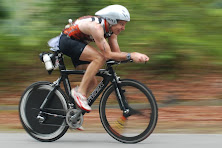Simon says: - I have found this article to be extremely useful in improving my swimming of late (yes I've also upped my time in the water considerably too which helps of course) but certainly these tips (possibly with the exception of 6 and 10) are extremely relevant for triathletes - coupled with the advice to only focus on one a week they work wonders.
 Although not even the world's best coach would be capable of providing a written list that could guarantee success, the following 10 points are core things to remember when attempting a perfect freestyle stroke (also known as the crawl).
Although not even the world's best coach would be capable of providing a written list that could guarantee success, the following 10 points are core things to remember when attempting a perfect freestyle stroke (also known as the crawl).With luck and perhaps a little poolside advice from another swimmer or instructor, these 10 items should ensure that you have the basic freestyle stroke mechanics down pat. You may already have several of them mastered, or you may just be starting to learn how to swim. Either way, there's no better time to make technical improvements than now.
Take one tip per week and only concentrate on that specific aspect of your stroke. The next week, choose to work on another tip, but remember the one you practiced the week prior. In 10 weeks time, not only should your stroke be markedly improved, but the improvements will feel natural and require less concentration because you added them together slowly over the course of a few months.
Rather than information-overloading yourself with too many things all at once (a common problem at weekend-long swim clinics), you will have taken several months to carefully master all the different, basic elements.
1. Head Position
Body position in the water is the most important component to swimming efficiently, and the position of your head dictates the position of the rest of your body. Look forward, with your hairline cresting the surface of the water in front of you (if your hairline is receding, then make sure that your forehead is just below the surface!).
Your neck and upper-back muscles should be relaxed, and assuming that your body is parallel to the bottom of the pool (as it should be), your head should be cocked forward about 45 degrees. If you "bury" your head into your chest, it will serve as a 25-pound form of resistance. It also will alter your body position by forcing your upper body to dive down and your hips to breach.
Conversely, if you look forward too far, your face will serve as resistance and your neck and upper-back muscles will tense up, causing fatigue and discomfort.
2. Reach Forward
With each stroke, make sure you are extending your arm to its maximum length. Many swimmers place their hand in the water in front of their head and begin their underwater pull. Instead, concentrate on placing your hand in the water about 15 inches in front of you, and then reach forward an additional 6 inches by extending your arm from your shoulder.
That little movement involving your shoulder (imagine you are standing and trying to reach for a ceiling just beyond your reach) can lengthen and smooth out your stroke for maximum efficiency.
3. Body Rotation
Body rotation is somewhat related to reaching forward, in that by pivoting your body with each stroke, you facilitate your shoulders extending forward at the end of each stroke. When your right arm is fully extended in front of you (and your left is about to exit the water behind you for its recovery), your body should be pivoted right.
This means the entire right side of your body should be submerged and facing the bottom of the pool, while the entire left side of your body should be breaching toward the ceiling/sky. With the next stroke, your body pivots to the left, altering your position about 120 degrees. Picture a rotisserie chicken being pivoted on the axis of the spit, and that is how your body should rotate with each stroke.
4. "Hourglass" Pull
When you are pulling your body through the water with your arms, you want to maximize the amount of water pulled. Since the shortest distance between two points is a straight line, the last thing you want to do when swimming is pull your arm through the water in a straight line. Instead, practice an S shape (a longer way of completing each stroke), so that if you were to pull both arms together simultaneously, the resulting path would resemble an hourglass silhouette (this simultaneous silhouette should also diagram your butterfly underwater pull).
At the beginning of the stroke, the hand extends out, away from your body. Keep your elbows high. As you catch the water, curve your hand back inward toward your belly button, then out again by your hip as your hand exits the water.
5. Finish the Stroke
Even some of the world's best swimmers end up shortening their strokes when they get tired, pulling their hands out of the water prematurely at their waist area rather than by their upper thigh. As your arms complete their underwater hourglass pull, they should fully extend behind you, by your sides, so that your thumbs graze the side of your thighs below your suit-line.
Many swimmers begin bending their elbows toward the end of their stroke and pull their arms out of the water before allowing them to finish their path. By shortening their stroke, these swimmers lose efficiency while actually expending more energy because they are taking more strokes per lap (essentially spinning their wheels).
6. Sprint Flutter Kick
Kicking takes up a lot of energy, which is why it's often relegated to the last lap of an event (especially a distance event). Sprinters rely more heavily on kicking, but regardless of your specialty, it is important to master a kick that works for you. Too often, swimmers end up creating added resistance with an incorrect kick that actually serves to slow them down!
A sprint flutter kick should be a fast, underwater up-and-down motion, alternating both feet. Create as little white-water as possible and keep your feet submerged. As your body rotates (see tip No. 3), your feet should rotate with it. Be careful not to splay your feet out horizontally for balance ("scissoring") as you rotate your body from side to side.
Rather, keep your feet in alignment with the rest of yourself and avoid breaking out of the narrow path your head and shoulders cut through the water (imagine swimming through the hole in a tire, keeping your feet close together as you slide through so as not to hit the edges).
7. Distance Crossover Kick
Distance kicking differs from sprint kicking in that it's not meant to propel you forward as much as it's meant to keep your rhythm while helping you stay afloat. Indeed, in longer races, attempting a sprint flutter kick will put you into oxygen depletion within laps, and you will crash and burn.
In races lasting a half-mile or more, it's best to maintain a crossover kick, which is when you cross your ankles with each (or every other) kick. Crossover kicking comes naturally to some swimmers while seeming extremely unnatural to others. Not surprisingly, sprinters tend to gravitate toward a sprint flutter kick while distance swimmers find themselves crossing over.
Concentrate on what comes naturally to you, then try the different technique and see how it feels. Remember that the crossover kick is meant to be less physically exerting for longer events, and is thus not as effective as a means of propulsion. However, it is extremely useful in keeping one's lower body afloat while conserving valuable energy during endurance events.
8. Breathing Head Position
When turning your head to breathe, make sure to turn it 90 degrees to the side. Many swimmers make the mistake of turning their head about 100 degrees so that their entire face (and both eyes) are above the water's surface. You want to try to keep your head parallel to the surface with one eye above and one eye submerged. Turning your head any more is unnecessary; it requires more effort and can result in increased resistance as your body corkscrews out of control.
Also, take care not to lift your head forward to breathe; some novice swimmers lift their heads up and over rather than just to the side. The only time you should lift your head up is when you are sighting during open water swims. Otherwise, lifting your head is like using your face to put on the brakes; you create resistance in the water while putting more strain on your neck muscles.
9. Breathing Pattern
It is best to breathe on both the left and right sides (bilateral breathing). This serves to even out your stroke and keep your body balanced in the water. Swimmers who only breathe on one side tend to have an uneven stroke turnover, and they miss out on what their competition is doing on their blind side. They can also end up swimming in an arc rather than a straight line in open water.
In extreme cases, swimmers who favor one side end up with a slight curvature of the spine over time (scoliosis). Take the time to teach yourself to be a bilateral breather. There are no disadvantages.
10. Starts and Finishes
When pool swimming, most people disregard the importance of their takeoff and their finish. Even when pushing off the wall for a set of repeats, take the time to streamline with your arms clasped behind your head in a v, with your hands together. Finish each repeat with a strong stroke into the wall, rather than slowing down and coasting in with your head raised.
Being a perfectionist conditions you to race better and make every moment count. Remember that you learn through repetition, and if you practice sloppy starts or finishes you may end up just as careless during a race. Besides, keep in mind that the more you streamline off of each wall, the less you have to swim on that given lap!


No comments:
Post a Comment